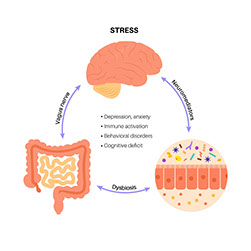POSTED 17.11.22 / BY C YATES
beyond mind & body to thrive & flourish
CATEGORIES
Design
Future
Connected
Methodology
Innovation
Technology
ABOUT ME
I am passionate about innovative design and creating user experiences at the intersection of art, science and technology.
RELATED POSTS
Design Methods
Cultivating Micro-Moments
In my previous article documenting my experience and learnings from a year of quantifying and measuring my well-being, understanding is the first step on a path of change and transformation from surviving and languishing to thriving and flourishing. For this to work involves thinking about well-being as a system where the bodily aspects such as sleep, activity, and nutrition are in harmony with the mental aspects of stress, anxiety, depression, and self-esteem. Indeed physical health and emotional well-being are intimately intertwined in what’s become known as the mind-body connection. Our chemistry and biology impact our mood and emotions, as well as thoughts and beliefs. With all of these factors combined, they play a major role in influencing our stress and physical health.
This is how talk therapies, specifically Cognitive Behavioural Therapy CBT can significantly alter the way the brain works. CBT focuses on teaching individuals how to identify and change thought patterns. The goal is to consciously activate positive thoughts and behaviours until these responses become more automatic. Researchers have discovered that in the process, people’s brains and nervous systems actually change.
Research on yoga and meditation has further explored the connection between mind, body, and spirit. Studies show that the mindful movement and breathing done in yoga activates the relaxation response (rest-and-digest system), via the vagus nerve. Consequently, yoga moves the nervous system out of the “fight, flight, or freeze” response associated with stress, and into the “rest and digest” response, thus increasing emotional well-being.
What goes into our body also impacts our mental well-being. What we eat has the power to prevent or help reverse mental health challenges. Research has demonstrated the impact of food on mood, and specific nutrients have been linked to measurable positive outcomes in mental and emotional well-being. In addition, the mind-body connection manifests in the communication between the brain and the gut. About 95% of serotonin, one of the primary hormones involved in mood and emotion regulation, is produced in the gastrointestinal tract. Sometimes called “the second brain” this enteric (intestinal-related) nervous system consists of some 100 million neurons in the walls of the gut. Information travels mostly from the gut to the brain, rather than vice versa. As a result, researchers have found that people with healthy, diverse gut microbes are less likely to suffer from anxiety and depression.
Any one who read my previous article (and if you haven’t I suggest you do, as with most sequels it is best to watch the original first) will know that working on mind and body leads to a routine where positive actions are integrated into your “personal health ecology” (PHE): an individual’s ecosystem of resources and practices to manage your well-being. PHEs include a wide variety of activities, practices, and resources used to pursue health, make decisions, and interact with health care providers.
Knowing your PHE allows you to become aware of the patterns and triggers that could impact well-being and draw on the resources to either combat or better cope with the causalities. It also aligns well-being with the process of living and growing, being part of your social interactions, work / life experiences, environmental influences, and worldly dynamics. However to really thrive and flourish there is a third musketeer to mind and body; that of purpose and meaning, this is what I am exploring with this sequel.
Happiness affects our health more than our health affects our happiness. A very famous study showed that 80 percent of people felt their life to be average or above average after becoming paraplegics. Being mentally well is very positively affected by being physically well; in fact, exercise is now considered to be the best cure for most cases of depression. Severe clinical depression can also be regulated better with exercise as well as medication. Several recent studies have shown that there is a positive relationship between exercise and subjective well-being, and it is also the case that the more active you are, the less likely you are to suffer anxiety and stress. It would seem from this, as many people believe, the goal of thriving and flourishing is happiness. Whilst this is an important aspect of life it should not be seen as the ultimate goal. Sometimes feelings of unhappiness or dissatisfaction just seem to find us, and it’s up to us to take the time to explore why this might be.
"Happiness does not come from doing easy work but from the afterglow of satisfaction that comes after the achievement of a difficult task that demanded our best." - Theodore Isaac Rubin
Satisfaction with life
One idea put forward is The Satisfaction With Life Scale (SWLS) first created by researchers Diener, Emmons, Larsen, and Griffin (1985) and published in an article in the Journal of Personality Assessment. The scale was developed as a way to assess an individual’s cognitive judgment of their satisfaction with their life as a whole. The SWLS is a very simple questionnaire made up of five statements which are rating using a seven-point scoring system, with 1 being “strongly disagree” and 7 being “strongly agree.”
- In most ways, my life is close to my ideal.
- The conditions of my life are excellent.
- I am satisfied with my life.
- So far, I have gotten the important things I want in life.
- If I could live my life over, I would change almost nothing.
The first thing to notice is there is not a direct question about how happy someone feels, as it is focused on the cognitive component of well-being and not the emotional, as the cognitive component has been more closely conceptualised with life satisfaction. I would go further and say that life satisfaction is closer to understanding thriving and flourishing, such that SWLS scores of 26 - 35 ie. Satisfied or extremely satisfied can be equated with flourishing, and scores of 9 - 14 ie, dissatisfied or extremely dissatisfied can be equated with languishing. My score at the start of this quest is 23, close but sitting in the neutral zone. According to research this is where the majority of people score themselves. This score means you are generally satisfied, on an average day-to-day basis; however, there are areas you’d really like to improve. The suggestion is rather than there being one or two things that you feel would give you greater satisfaction, you might feel that small improvements across all domains of your life would lead to a higher sense of life satisfaction.
Governments around the world are recognising the importance of measuring subjective well-being as an indicator of progress. But how should well-being be measured? A conceptual framework was devised in 2011 by the Well-Being Institute & Department of Psychiatry at the University of Cambridge in the UK, which equates high well-being with positive mental health. They identified ten features of positive well-being by combining feeling and functioning, i.e. hedonic and eudaemonic aspects of well-being: competence, emotional stability, engagement, meaning, optimism, positive emotion, positive relationships, resilience, self esteem, and vitality. An operational definition of flourishing was developed, based on psychometric analysis of indicators of these ten features, using data from a representative sample of 43,000 Europeans. 23 countries participated in the survey across three regions: Northern Europe (Denmark, Finland, Norway, Sweden), Southern/Western Europe (Austria, Belgium, Cyprus, France, Germany, Ireland, Netherlands, Portugal, Spain, Switzerland, United Kingdom), and Eastern Europe (Bulgaria, Estonia, Russian Federation, Poland, Slovakia, Slovenia, Ukraine). The results reveal a very large variation across Europe, with high consistency across regions. All the Nordic countries are in the top third of the distribution, while all the Eastern European countries are in the bottom half. With respect to individual countries, there was more than a four-fold difference between the highest and lowest countries. Denmark has by far the highest rate of flourishing (40.6%), followed some way behind by Switzerland (30.2%) and Austria (27.6%). At the other end of the scale, three countries have rates of less than 10%: Slovakia (9.9%), Russian Federation (9.4%), and Portugal (9.3%). There are also striking differences in country profiles across the 10 features. These profiles offer fresh insight into cultural differences, and indicate which features may provide the most promising targets for policies to improve well-being. Comparison with a life satisfaction measure shows that valuable information would be lost if well-being was measured just by life satisfaction. Taken together, the findings reinforce the need to measure subjective well-being as a multi-dimensional construct.
Harvard program
Harvard's Institute for Quantitative Social Science aims to study and promote human flourishing, and to develop systematic approaches to the synthesis of knowledge across disciplines. Their Flourishing Program, (Tyler J. VanderWeele) includes a measure to gauge a person’s overall physical, mental and emotional well-being. The measure consists of two questions in each of six domains; Happiness and Life Satisfaction, Mental and Physical Health, Meaning and Purpose, Character and Virtue, Close Social Relationships, and Financial and Material Stability. While there is no specific score to determine if someone is definitely flourishing, the higher the score, the better (try it out here https://flourishing.app/about/measures/flourishing/new?q=0). The national average based on several 000’s of responses was about 70 before the pandemic and 65 in June 2020. You respond to the 12 questions in the range of 0 (not satisfied at all) to 10 (completely satisfied). My score at the start of this exploration was 65, so pretty much in line with the average, aligning with the previous SWLS score indicating that to be flourishing you perhaps need to be scoring above average.
What is interesting about this measure is how the scores breakdown across each of the six domains. The two in particular I found worthy of more attention were Meaning & Purpose, and Character & Virtue, as they sit outside the mind & body concept of well-being. Whilst it is clear that meaning and purpose have a key role in the pursuit of flourishing, improving character & virtue may be a part of the effort or work required to realise this, in the same way that physical health is key to well-being there is a need for effort in the form of exercise to achieve good physical health.
“Positive psychology takes you through the countryside of pleasure and gratification, up into the high country of strength and virtue, and finally to the peaks of lasting fulfilment, meaning and purpose.” - Seligman, 2002
PERMA model
Many people may have heard of Abraham Maslow (1962) description of thriving and flourishing with his characteristics of a self-actualised state of mind. This description of self-actualisation has been used by others to go deeper into this topic, one of those is Dr. Martin Seligman with the introduction of the PERMA model in 2012. This is meant to outline the characteristics of a flourishing individual and establish a Wellbeing Theory (WBT). The theory has five components that people pursue because they are intrinsically motivating and they contribute to wellbeing. These five elements or components are: Positive emotion, Engagement, Relationships, Meaning, Accomplishments. Research has shown significant positive associations between each of the PERMA components and physical health, vitality, job satisfaction, life satisfaction, and commitment within organisations.
The first element; Positive emotion include hope, interest, joy, love, compassion, pride, amusement, and gratitude. Positive emotions can be cultivated or learned to improve wellbeing and can undo the harmful effects of negative emotions to promote resilience.
The second element; Engagement is similar to Csikszentmihalyi’s (1989) concept of “flow.” Flow includes the loss of self-consciousness and complete absorption in an activity. It is about living in the present moment and focusing entirely on the task at hand. People are more likely to experience flow when they use their top character strengths in new ways.
The third element; Relationships encompass all the various interactions individuals have with partners, friends, family members, colleagues, bosses/mentors/supervisors, and their community at large. Relationships refer to feeling supported, loved, and valued by others.
The fourth element; Meaning, Seligman discussed meaning as belonging and/or serving something greater than ourselves. Having a purpose in life helps individuals focus on what is really important in the face of significant challenge or adversity. This is different for everyone and may be pursued through a profession, a social or political cause, a creative endeavour, or a religious/spiritual belief. It may be found in a career or through extracurricular, volunteer, or community activities. A sense of meaning is guided by personal values, and people who report having purpose in life live longer and have greater life satisfaction and fewer health problems.
The fifth element; Leeloo (sorry could not resist the movie reference!) Accomplishment also known as achievement, mastery, or competence. A sense of accomplishment is a result of working toward and reaching goals, mastering an endeavour, and having self-motivation to finish what you set out to do. This contributes to wellbeing because individuals can look at their lives with a sense of pride. Accomplishment includes the concepts of perseverance and having a passion to attain goals. Flourishing and wellbeing come when accomplishment is tied to striving toward things with an internal motivation or working toward something just for the sake of the pursuit and improvement.
Flow
The PERMA model element of engagement refers to flow; When we’re in flow, we feel absorbed in a meaningful challenge. Time slips away and we feel utterly present. This concept, outlined by Mihaly Csikszentmihalyi in his book, Flow: The Psychology of Optimal Experience, is described as being a possible antidote too languishing. So, how can we find our flow? When you find the right balance between skill and challenge, you’re likely to feel happy, powerful and full of energy – in fact, you’ll be flowing.
Support your focus; The reason some of us have perhaps struggled to find flow during the pandemic is because flow requires focus, something that’s felt elusive. Finding ways to support your focus will help you feel more motivated and will help you settle into flow more easily.
Researcher at the Northeastern University, Boston have devised; A computational theory of the subjective experience of flow. Which aims to outline a basic equation underlying the computational theory of flow: it computes that the mutual information (I) between desired end states (E) and means of attaining them (M), can be expressed as I(M;E). Exercise is one example used to illustrate the concept. When people exercise, they have a desired end state, say, losing 10kg. People also have a means of attaining their end state, perhaps walking or jogging. Whether they walk or jog and how often and far is the means and is informative of whether they will achieve their end state.
“Our theory says that the more informative a means is, the more flow someone will experience while performing it. The formula is a way of mathematically quantifying exactly how informative a particular means happens to be.” - Melnikoff
The researchers say that our flow is maximised when the mutual information we have about how the means will affect the ends is highest – in other words, when we know more about how our actions will impact our goals. This supports the notion that understanding more about the nature (actions) of you need to do is important to achieve flourishing.
The PERMA model like the Harvard program high-lights the need for meaning and purpose in order to flourish. In addition it adds the idea of accomplishment and achieving goals. From the research it feels that a way to start in the pursuit of thriving and flourishing is to both consider my goals alongside understanding the meaning and purpose and what is really important in the face of significant challenge or adversity. With this knowledge it would be possible to consider the character strengths and virtues (actions) necessary to accomplish my goals, and attain the personal values to support purpose and meaning in life.
GALLERY














CBT can alter the way the brain works to improve well-being
The second brain resides in the gut
Happiness affects our health despite physical challenges
Maslows' hierarchy of needs including self-acualisation (flourishing) and self-transcendence (thriving)
Denmark and Nordic countries lead the table in life satisfaction
Positive psychology is like taking a pathway to the peaks of lasting fulfillment - Seligman
Running can help you achieve a sense of flow
Finding your goals does not need to be arduous, start small and celebrate small wins
Understand the character strengths you need to achieve your goals
Emotional intelligence (EQ) is about understanding, using, and managing emotions in a positive way
My holistic view of character and virtue strengths
Pathways thinking combined with agency can be a bridge to flourishing
Joy and happiness that last come from living a meaningful and purposeful way
The meaning, your story, defines who you are!
<
14 - 14
>
"Setting goals is the first step in turning the invisible into the visible." - Tony Robbins
My goals
Seeking to capture and articulate this was no easy and straight forward task, and reflects many hours of inner thought, contemplation, and reflection. Equally, I realise, it is not necessary to go for a deep understanding, as goals can evolve and change, starting small and celebrating small wins has never been more important, and it could be just the boost to step away from languishing.
What I have come to realise following the pandemic and my year of quantifying and measuring my well-being, is I flourish in environments where well-being is a key part of my life and lifestyle, so achieving the right ‘work / life’ balance is important to me. I have also come to realise over the course of my career and personal life I thrive in settings where I can learn and explore new possibilities. Most recently I have also recognised my sense of purpose comes from using my knowledge and skills to help drive change, and deliver impact in the world. Throughout my life I have derived meaning by honoring and respecting people I have come to know, admire, and love, and to also cultivate new friendships and relationships. In essence my goal could be described as finding a context where I can drive change and deliver impact, respecting others and my need for well-being and cultivating new possibilities.
Character and Virtues
According to work by Christopher Peterson & Martin E. P. Seligman a catalog of Virtues and Strengths can be grouped into six areas; Wisdom and knowledge, Courage, Humanity, Justice, Temperance, Transcendence.
Strengths of wisdom and knowledge include positive traits related to the acquisition and use of information in the service of purpose and meaning. Many of the strengths have cognitive aspects leading many philosophers concerned with virtue to consider wisdom or reason as the chief virtue making all others possible. There are five character strengths studied by psychologists in which cognition is especially salient; Creativity, Curiosity, Open-mindedness, Love of learning, and Perspective.
As an individual difference, creativity entails two essential components. First, a creative person must produce ideas or behaviours that are recognisably original, novel, surprising, or unusual. However, originality per se does not define creativity. The relevant behaviours or ideas must also be adaptive. The individual’s originality must make a positive contribution to that person’s life or to the life of others. Curiosity can be defined as one’s intrinsic interest in ongoing experience. Curious people pursue experiential novelty, variety, and challenge. Like creativity, curiosity is a key criteria for a character strength. A strength included in virtually all virtue catalogs, ancient and modern, is one that refers to a way of thinking variously referred to as judgment, critical thinking, rationality, or open-mindedness. Love of learning can be conceptualised as an inherent part of all human nature, especially evident in the very young, who are driven to learn about the world they have entered, but also apparent across the life span: the drive to interact competently with the world, which necessarily entails learning how to do so. People who possess the general trait of love of learning are positively motivated to acquire new skills or knowledge or to build on existing skills and knowledge. Perspective refers to the ability to take stock of life in large terms, in ways that make sense to oneself and others. Perspective is the product of knowledge and experience, but it is more than the accumulation of information. It is the coordination of this information and its deliberate use to improve well-being.
Emotional Intelligence (EQ)
Another way to consider character and virtue is the measure of emotional intelligence (EQ) which is the ability to understand, use, and manage your own emotions in positive ways to relieve stress, communicate effectively, empathise with others, overcome challenges and defuse conflict. Researchers suggest that there are four different levels of emotional intelligence:
Perceiving emotions; the first step in understanding emotions is to perceive them accurately. In many cases, this might involve understanding nonverbal signals such as body language and facial expressions.
Reasoning with emotions: The next step involves using emotions to promote thinking and cognitive activity. Emotions help prioritise what we pay attention and react too.
Understanding emotions: The emotions that we perceive can carry a wide variety of meanings. If someone is expressing angry emotions, the observer must interpret the cause of the person's anger and what it could mean.
Managing emotions: The ability to manage emotions effectively is a crucial part of emotional intelligence and the highest level. Regulating emotions and responding appropriately as well as responding to the emotions of others are all important aspects of emotional management.
Measuring EQ can be done using self-report tests. On such tests, people respond to questions or statements by rating their own behaviours. For example, on a statement such as "I often feel that I understand how others are feeling," a test-taker might describe the statement as disagree, somewhat disagree, agree, or strongly agree. Another way to measure is with ability tests which involve having people respond to situations and then assessing their skills. For example a person might be given this scenario; Two of your friends are fighting so you…and then offered the following responses to choose from:
- Try to help them understand each other's point of view
- Pick a side and bad-mouth the other friend
- Avoid both of them until the fight is over
- Let them vent their emotions to you
The answers given in response to the scenario can be interpreted by a third party in relation to EQ. Taking an ability type test it turns out I have high emotional intelligence, which for a product designer is a good thing since empathetic understanding of emotions can help reveal the true nature of a problem for which a design can then be created. It is also not the final score that is key, but in understanding the characters and virtues that promote the qualities of EQ such as self-regard, inner strength, interpersonal relationships, social responsibility, impulse control, problem solving, emotional self-awareness, stress tolerance, empathy and warmth towards others.
Armed with the recognition of Flow, the knowledge of PERMA, the definitions of character strengths, and the understanding of EQ, I set about using design thinking to create my own holistic and relatable set of five character strengths:
Wisdom: cognitive strangles that entail the acquisition and use of knowledge for problem solving, accomplishment, mastery, and meaning including; creativity (originality, ingenuity), curiosity (interest, novelty seeking, openness to experience), and open-mindedness (judgement, critical thinking).
Relationships: Interpersonal strengths that involve tending and befriending others, social responsibility, and valuing close relationships including; kindness (generosity, nurturance, care, compassion), social intelligence (being aware of the motives and feelings of other people and oneself), citizenship (social and climate responsibility), fairness (treating all people the same).
Emotion: Emotional inner strength and self-regard that involve the exercise of will to accomplish goals in the face of external or internal opposition including; persistence (perseverance, industriousness), integrity (authenticity, honesty), vitality (zest, enthusiasm, visor, approaching life with excitement and energy), resilience, engagement and flow.
Resilience / Control: Strengths that protect against excess, impulses, and aggression in the pursuit of meaning and accomplishment including; prudence (being careful about ones choices and not taking undue risks), self-regulation (self-control and regulating what one feels and does, being disciplined), resilience.
Meaning: Strengths that forge connections to the larger universe and provide meaning, stress tolerance, understanding ones mood including appreciation of beauty and excellence (awe, wonder, elevation), gratitude (being aware and thankful for the good things that happen), hope (optimism, future-mindedness, future orientation), humour (playfulness).
There is a school of thought that the ability to see clearly what goals we have and to be able to work out how we are going to get there is called pathways thinking. The ability to initiate the action, generate and sustain the confidence and motivation to carry out the plan ie. ‘travel the pathway’ is called agency thinking. To flourish and thrive one simply combines pathways thinking with agency thinking.
Having engaged in pathways thinking by searching my inner self and establishing goals, I can employ agency thinking and the five character strengths to work on those areas that need more focus to achieve these goals. For me that equates to cultivating new relationships, elements of resilience, and the fabric of emotions that support meaning.
I hope by reading this article it does not take a positive psychologists to tell you that a flourishing and thriving life is made up of more than just transitory good feelings, and doing what we like best. We cannot live only as ungoverned pleasure seekers. Much of what brings us the most joy can be things we struggle to achieve and choose to address for long-term rewards. Joy and happiness that last come from living in a meaningful and purposeful way, such that the joy and satisfaction you experience are not dependent on satiating your transient desires. Many of the positive interventions that affect well-being are in some way encouraging you to look again at your life through newer, or older, eyes, to remind yourself of the good things you have and to challenge your complacencies.
Having meaning and purpose in your life gives you the ‘why’ you do what you do. Knowing that your life has meaning helps you face up to difficulties and overcome hardship. The meaning, ‘your story’, defines your role, making who you are, and what you do, matter.
LEAVE A COMMENT











































































